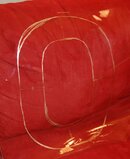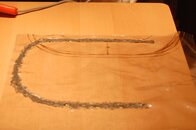Well, after experimenting with my horse collar "wing" I've decided it's time to start from scratch.
I'm very familiar with PVC material (the soft kind that is like fabric) having made several boats from it, and I recently acquired a "plastic welder" for that and some other interests. Basically it's a hot air gun with an attachment for feeding "welding rods" of the appropriate plastic material. Because of these two factors, I'm planning a PVC wing from scratch.
Obviously RF welding is the best solution for bladders, but heat welding works the same way, though with less consistent results and at a slower pace.
After reading a and participating in a bunch of threads about wings I decided the full donut is better than a horseshoe, and I don't like the asymmetric nature of the horse collar I have. (It's also simpler to build.) That considered, the wing needs to be between 15 and 20 pounds of lift, which equates to 2 to 2.5 gallons of volume or roughly 7.5 to 9.5 liters. I've decided on 18 pounds as that will more than cover even my cold water lift requirements and give me a little extra for accessories I might acquire in the future.
18 pounds is 8.18 liters (2.15 gallons) of volume, which is ~500 cubic inches. (Volume of a torroid is 2(pi^2)r^2R where r is the radius of the bladder tube and R is the circumference of the centerline of the bladder.)
So, with that in mind, I did some tinkering on the calculator and came up with the following dimensions: r=.8 in, and R=39.5 in.
This yields a toroid that has an approximately 10.5 inch minor axis with a 13.5 inch major axis and a 1.6 inch diameter tube for the bladder. This is just large enough to accommodate the 11 inch hole spacing of an STA. With 18 pounds of lift, I get about 4 pounds (22 %) of leeway in my required cold water weight diving wet. This should accommodate any difference of real lift with a tank compared to the dry lift calculated for no tank. To add a little more safety margin Ill probably push the dimensions up another 1/4inch. That should accommodate not only margin of error for differences in lift with and without the tank, but also any error that I should encounter during the welding process by doing it by hand.
So, all my dimensional calculations in place, lets look at the cost of materials:
Note: Prices are for consumer retail pricing, not wholesaler or discounted bulk pricing, and are rough estimates rounded to the nearest dollar as of December 2010.
In some thread from 2006 or 2007 Tobin mentioned some 30 parts for a wing, but this is a list of all I could come up with. I probably missed some or things have become simpler since that thread, as I can only come up with 12 items. (It's also possible he's counting sub-components or tools that I missed in my count.)
20 mil PVC material, clear: $12/yard*1/2 yard = $6 (1 yard of material is 60 inches wide so can fit both sides of the bladder)
PVC welding rods: Qty 50 48 rods/$16 * 2 rods = $0.64 (2 rods because Im planning for double welds)
Power inflator: $30
Power inflator corrugated hose: $6
Power inflator elbow: $9
Power inflator gasket: $1
Power inflator flange: $9
OPV: $12
OPV flange: $9
OPV Gasket: $1
800 Cordura Nylon: $12/yard* ½ yard=$6
Polyester thread: $2
Zip ties: 1000/$20 * 2 ties=$0.04
Total: ~$83 + Labor
Labor: at least 2 hours because Im doing this all by hand. This is what actually makes this cost prohibitive to do on a one-off scale and why the cost of a reasonably priced wing is worth it unless youre doing this for fun, which I am.
Because Im doing this for fun, and I already have all the necessary equipment to do this, I dont count my labor. As such, its not really a fair price comparison. With my labor actually included it would be well over the $200 entry price for wings.
I also happen to have a lot of this material on hand already that is left-over from other hobbies and from salvaging as many BCs as I can from Craigslist, so my actual material costs are already sunk and I generally dont consider them either. Specifically the nylon, the pvc, and the OPV and Power inflator, which represent the big expenses for materials. I can probably salvage some of the flanges and a few gaskets, but its not really a good bet that those will be reusable.
So, I'll get some pics up soon, but if anyone has any comments I'd like to hear them, especially if they are relative to the size calculations and whether my assumptions are correct or incorrect there.
I'm less interested in the "you're going to die" type comments because frankly, I think they're ridiculous, but they are sometimes entertaining to read anyway. For those that feel the need to point out my diving experience, I will try to be polite in any response but be aware that my diving experience has no bearing on my ability to build things as an engineer, even things that are diving related or "life sustaining".
I'm very familiar with PVC material (the soft kind that is like fabric) having made several boats from it, and I recently acquired a "plastic welder" for that and some other interests. Basically it's a hot air gun with an attachment for feeding "welding rods" of the appropriate plastic material. Because of these two factors, I'm planning a PVC wing from scratch.
Obviously RF welding is the best solution for bladders, but heat welding works the same way, though with less consistent results and at a slower pace.
After reading a and participating in a bunch of threads about wings I decided the full donut is better than a horseshoe, and I don't like the asymmetric nature of the horse collar I have. (It's also simpler to build.) That considered, the wing needs to be between 15 and 20 pounds of lift, which equates to 2 to 2.5 gallons of volume or roughly 7.5 to 9.5 liters. I've decided on 18 pounds as that will more than cover even my cold water lift requirements and give me a little extra for accessories I might acquire in the future.
18 pounds is 8.18 liters (2.15 gallons) of volume, which is ~500 cubic inches. (Volume of a torroid is 2(pi^2)r^2R where r is the radius of the bladder tube and R is the circumference of the centerline of the bladder.)
So, with that in mind, I did some tinkering on the calculator and came up with the following dimensions: r=.8 in, and R=39.5 in.
This yields a toroid that has an approximately 10.5 inch minor axis with a 13.5 inch major axis and a 1.6 inch diameter tube for the bladder. This is just large enough to accommodate the 11 inch hole spacing of an STA. With 18 pounds of lift, I get about 4 pounds (22 %) of leeway in my required cold water weight diving wet. This should accommodate any difference of real lift with a tank compared to the dry lift calculated for no tank. To add a little more safety margin Ill probably push the dimensions up another 1/4inch. That should accommodate not only margin of error for differences in lift with and without the tank, but also any error that I should encounter during the welding process by doing it by hand.
So, all my dimensional calculations in place, lets look at the cost of materials:
Note: Prices are for consumer retail pricing, not wholesaler or discounted bulk pricing, and are rough estimates rounded to the nearest dollar as of December 2010.
In some thread from 2006 or 2007 Tobin mentioned some 30 parts for a wing, but this is a list of all I could come up with. I probably missed some or things have become simpler since that thread, as I can only come up with 12 items. (It's also possible he's counting sub-components or tools that I missed in my count.)
20 mil PVC material, clear: $12/yard*1/2 yard = $6 (1 yard of material is 60 inches wide so can fit both sides of the bladder)
PVC welding rods: Qty 50 48 rods/$16 * 2 rods = $0.64 (2 rods because Im planning for double welds)
Power inflator: $30
Power inflator corrugated hose: $6
Power inflator elbow: $9
Power inflator gasket: $1
Power inflator flange: $9
OPV: $12
OPV flange: $9
OPV Gasket: $1
800 Cordura Nylon: $12/yard* ½ yard=$6
Polyester thread: $2
Zip ties: 1000/$20 * 2 ties=$0.04
Total: ~$83 + Labor
Labor: at least 2 hours because Im doing this all by hand. This is what actually makes this cost prohibitive to do on a one-off scale and why the cost of a reasonably priced wing is worth it unless youre doing this for fun, which I am.
Because Im doing this for fun, and I already have all the necessary equipment to do this, I dont count my labor. As such, its not really a fair price comparison. With my labor actually included it would be well over the $200 entry price for wings.
I also happen to have a lot of this material on hand already that is left-over from other hobbies and from salvaging as many BCs as I can from Craigslist, so my actual material costs are already sunk and I generally dont consider them either. Specifically the nylon, the pvc, and the OPV and Power inflator, which represent the big expenses for materials. I can probably salvage some of the flanges and a few gaskets, but its not really a good bet that those will be reusable.
So, I'll get some pics up soon, but if anyone has any comments I'd like to hear them, especially if they are relative to the size calculations and whether my assumptions are correct or incorrect there.
I'm less interested in the "you're going to die" type comments because frankly, I think they're ridiculous, but they are sometimes entertaining to read anyway. For those that feel the need to point out my diving experience, I will try to be polite in any response but be aware that my diving experience has no bearing on my ability to build things as an engineer, even things that are diving related or "life sustaining".





